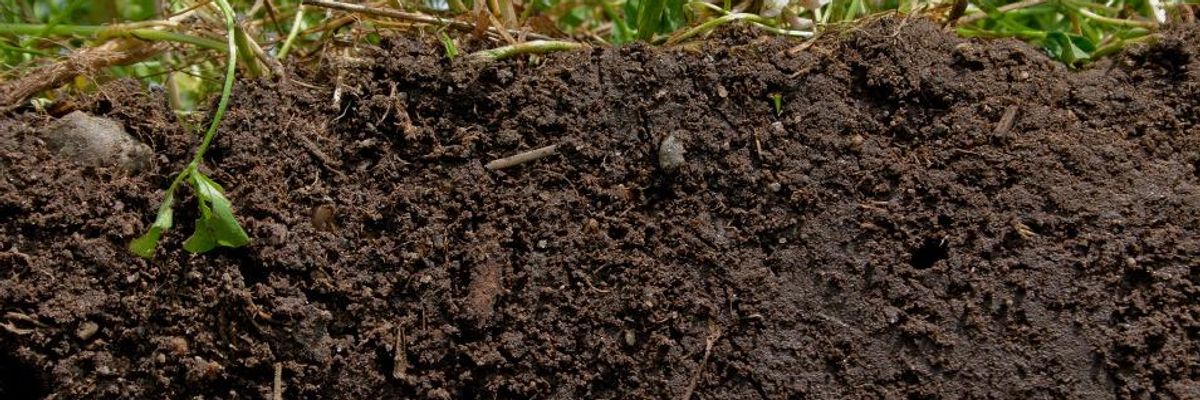

SUBSCRIBE TO OUR FREE NEWSLETTER
Daily news & progressive opinion—funded by the people, not the corporations—delivered straight to your inbox.
5
#000000
#FFFFFF
To donate by check, phone, or other method, see our More Ways to Give page.


Daily news & progressive opinion—funded by the people, not the corporations—delivered straight to your inbox.

Healthy soil. (Photo: Natural Resources Conservation Service Soil Health Campaign/flickr/cc)
What if there were a risk-free way of helping to mitigate climate change while simultaneously addressing food and water security?
A new report from the Center for Food Safety's Cool Foods Campaign says that such an opportunity is possible, and it's right below our feet.
Soil & Carbon: Soil Solutions to Climate Problems outlines how it is possible to take atmospheric CO2, which is fueling climate change, and plug it into the soil. Far from moving the problem from one place to another, this shift can reduce ocean acidification because the oceans are no longer the sink for vast amounts of CO2, and can regenerate degraded soils by providing needed carbon.
The report lays out the problem in this way:
Humans are altering the chemistry of where carbon is stored, and climate change is a manifestation of that alteration.
Another way of looking at the problem is that too much of the carbon that was once in a solid phase in the soil is now a gas. As a result, there is too much carbon in the atmosphere, too much in the ocean, but not enough stable carbon where it once was, in the soil.
The report adds that "cultivated soils globally have lost 50-70 percent of their original carbon content." Multiple factors have contributed to the problem, the report states: paving over land; converting grasslands to cropland; and agricultural practices that involve tillage and chemical inputs, which not only deprive soil of organic matter and rob it of the ability to store carbon but also contribute to flooding and erosion.

Just how much CO2 can be stored in soils is unclear, with one estimate cited in the report being 75-100 parts per million of CO.
But the bottom line, the report states, is that healthy soils will help communities have resilience in the face of climate change impacts.
The report concludes: "Unlike geoengineering, rebuilding soil carbon is a zero-risk, low-cost proposition. It has universal application, and we already know how to do it. All that stands in our way is a greater awareness of the opportunity and the political will to make it happen."
Donald Trump’s attacks on democracy, justice, and a free press are escalating — putting everything we stand for at risk. We believe a better world is possible, but we can’t get there without your support. Common Dreams stands apart. We answer only to you — our readers, activists, and changemakers — not to billionaires or corporations. Our independence allows us to cover the vital stories that others won’t, spotlighting movements for peace, equality, and human rights. Right now, our work faces unprecedented challenges. Misinformation is spreading, journalists are under attack, and financial pressures are mounting. As a reader-supported, nonprofit newsroom, your support is crucial to keep this journalism alive. Whatever you can give — $10, $25, or $100 — helps us stay strong and responsive when the world needs us most. Together, we’ll continue to build the independent, courageous journalism our movement relies on. Thank you for being part of this community. |
What if there were a risk-free way of helping to mitigate climate change while simultaneously addressing food and water security?
A new report from the Center for Food Safety's Cool Foods Campaign says that such an opportunity is possible, and it's right below our feet.
Soil & Carbon: Soil Solutions to Climate Problems outlines how it is possible to take atmospheric CO2, which is fueling climate change, and plug it into the soil. Far from moving the problem from one place to another, this shift can reduce ocean acidification because the oceans are no longer the sink for vast amounts of CO2, and can regenerate degraded soils by providing needed carbon.
The report lays out the problem in this way:
Humans are altering the chemistry of where carbon is stored, and climate change is a manifestation of that alteration.
Another way of looking at the problem is that too much of the carbon that was once in a solid phase in the soil is now a gas. As a result, there is too much carbon in the atmosphere, too much in the ocean, but not enough stable carbon where it once was, in the soil.
The report adds that "cultivated soils globally have lost 50-70 percent of their original carbon content." Multiple factors have contributed to the problem, the report states: paving over land; converting grasslands to cropland; and agricultural practices that involve tillage and chemical inputs, which not only deprive soil of organic matter and rob it of the ability to store carbon but also contribute to flooding and erosion.

Just how much CO2 can be stored in soils is unclear, with one estimate cited in the report being 75-100 parts per million of CO.
But the bottom line, the report states, is that healthy soils will help communities have resilience in the face of climate change impacts.
The report concludes: "Unlike geoengineering, rebuilding soil carbon is a zero-risk, low-cost proposition. It has universal application, and we already know how to do it. All that stands in our way is a greater awareness of the opportunity and the political will to make it happen."
What if there were a risk-free way of helping to mitigate climate change while simultaneously addressing food and water security?
A new report from the Center for Food Safety's Cool Foods Campaign says that such an opportunity is possible, and it's right below our feet.
Soil & Carbon: Soil Solutions to Climate Problems outlines how it is possible to take atmospheric CO2, which is fueling climate change, and plug it into the soil. Far from moving the problem from one place to another, this shift can reduce ocean acidification because the oceans are no longer the sink for vast amounts of CO2, and can regenerate degraded soils by providing needed carbon.
The report lays out the problem in this way:
Humans are altering the chemistry of where carbon is stored, and climate change is a manifestation of that alteration.
Another way of looking at the problem is that too much of the carbon that was once in a solid phase in the soil is now a gas. As a result, there is too much carbon in the atmosphere, too much in the ocean, but not enough stable carbon where it once was, in the soil.
The report adds that "cultivated soils globally have lost 50-70 percent of their original carbon content." Multiple factors have contributed to the problem, the report states: paving over land; converting grasslands to cropland; and agricultural practices that involve tillage and chemical inputs, which not only deprive soil of organic matter and rob it of the ability to store carbon but also contribute to flooding and erosion.

Just how much CO2 can be stored in soils is unclear, with one estimate cited in the report being 75-100 parts per million of CO.
But the bottom line, the report states, is that healthy soils will help communities have resilience in the face of climate change impacts.
The report concludes: "Unlike geoengineering, rebuilding soil carbon is a zero-risk, low-cost proposition. It has universal application, and we already know how to do it. All that stands in our way is a greater awareness of the opportunity and the political will to make it happen."